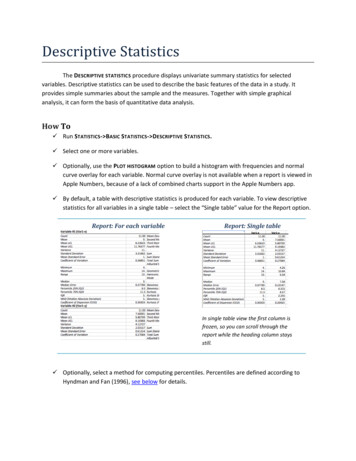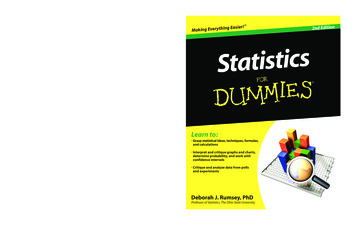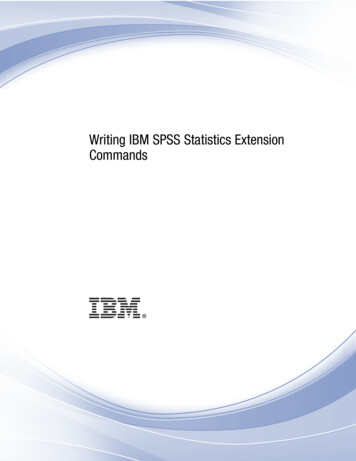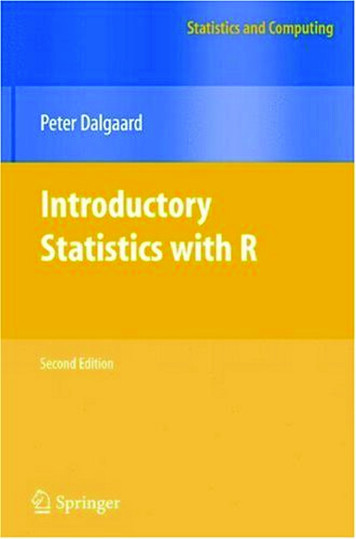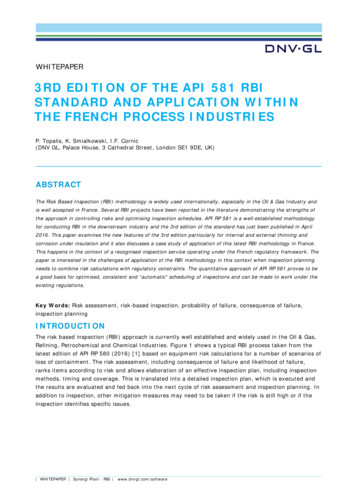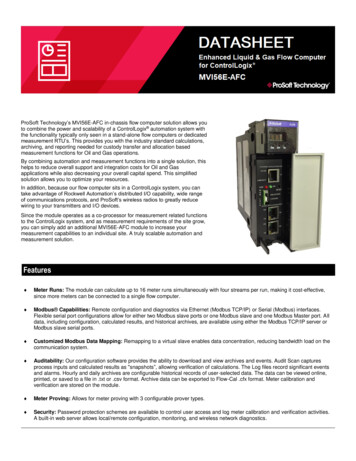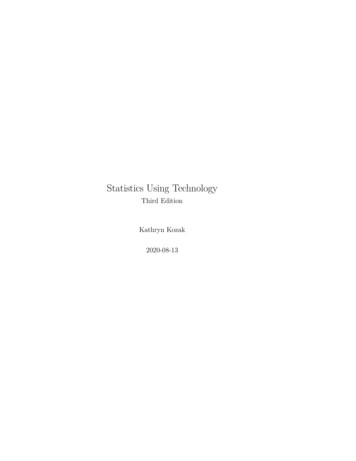
Transcription
Statistics Using TechnologyThird EditionKathryn Kozak2020-08-13
2College Mathematics for Everyday Life, 2nd Edition by Maxie Inigo, Jennifer Jameson, Kathryn Kozak,Maya Lanzetta, and Kim Sonier is licensed under a Creative Commons Attribution-ShareAlike 4.0International License.
ContentsPreface0.1 Acknowledgments: . . . . . . . . . . . . . . . . . . . . . . . . . .0.2 New to the Third Edition: . . . . . . . . . . . . . . . . . . . . . .0.3 Packages needed for R Studio: . . . . . . . . . . . . . . . . . . . .1 Statistical Basics1.1 What is Statistics? . . . .1.2 Sampling Methods . . . .1.3 Experimental Design . . .1.4 How Not to Do Statistics.5667991825302 Graphical Descriptions of Data372.1 Qualitative Data . . . . . . . . . . . . . . . . . . . . . . . . . . . 382.2 Quantitative Data . . . . . . . . . . . . . . . . . . . . . . . . . . 492.3 Other Graphical Representations of Data . . . . . . . . . . . . . 673 Numerical Descriptions of3.1 Measures of Center . . .3.2 Measures of Spread . . .3.3 Ranking . . . . . . . . .Data87. . . . . . . . . . . . . . . . . . . . . . . 87. . . . . . . . . . . . . . . . . . . . . . . 101. . . . . . . . . . . . . . . . . . . . . . . 1124 Probability4.1 Empirical Probability .4.2 Theoretical Probability .4.3 Conditional Probability4.4 Counting Techniques . .1231241301431545 Discrete Probability Distributions1575.1 Basics of Probability Distributions . . . . . . . . . . . . . . . . . 1585.2 Binomial Probability Distribution . . . . . . . . . . . . . . . . . . 1655.3 Mean and Standard Deviation of Binomial Distribution . . . . . 1716 Continuous Probability Distributions1776.1 Finding Probabilities for the Normal Distribution . . . . . . . . . 1833
4CONTENTS6.26.3Assessing Normality . . . . . . . . . . . . . . . . . . . . . . . . . 194Sampling Distribution and the Central Limit Theorem . . . . . . 2017 One-Sample Inference2157.1 Basics of Hypothesis Testing . . . . . . . . . . . . . . . . . . . . 2157.2 One-Sample Proportion Test . . . . . . . . . . . . . . . . . . . . 2277.3 One-Sample Test for the Mean . . . . . . . . . . . . . . . . . . . 2338 Estimation2638.1 Basics of Confidence Intervals . . . . . . . . . . . . . . . . . . . . 2638.2 One-Sample Interval for the Proportion . . . . . . . . . . . . . . 2668.3 One-Sample Interval for the Mean . . . . . . . . . . . . . . . . . 2719 Two-Sample Inference9.1 Two Proportions . . . . . . . . . . . .9.2 Paired Samples for Two Means . . . .9.3 Independent Samples for Two Means .9.4 Which Analysis Should You Conduct?.28928929531532910 Regression and Correlation33310.1 Regression . . . . . . . . . . . . . . . . . . . . . . . . . . . . . . . 33310.2 Correlation . . . . . . . . . . . . . . . . . . . . . . . . . . . . . . 35310.3 Inference for Regression and Correlation . . . . . . . . . . . . . . 35911 Chi-Square and ANOVA Tests36711.1 Chi-Square Test for Independence . . . . . . . . . . . . . . . . . . 36711.2 Chi-Square Goodness of Fit . . . . . . . . . . . . . . . . . . . . . 37311.3 Analysis of Variance (ANOVA) . . . . . . . . . . . . . . . . . . . 377
PrefaceI hope you find this book useful in teaching statistics. When writing this book, Itried to follow the GAISE Standards (GAISE recommendations. (2014, January05). Retrieved from Recommendations.pdf Teach statistical thinking.Focus on conceptual understanding.Integrate real data with a context and a purpose.Foster active learning.Use technology to explore concepts and analyze data.Use assessments to improve and evaluate student learningTo this end, I ask students to interpret the results of their calculations. I incorporated the use of technology (R Studio) for most calculations. Because ofthat you will not find me using any of the computational formulas for standard deviations or correlation and regression since I prefer students understandthe concept of these quantities. Also, because I utilize technology you will notfind the standard normal table, Student’s t-table, binomial table, chi-squaredistribution table, and F-distribution table in the book. Another difference between this book and other statistics books is the order of hypothesis testing andconfidence intervals. Most books present confidence intervals first and then hypothesis tests. I find that presenting hypothesis testing first and then confidenceintervals is more understandable for students. Lastly, I have de-emphasized theuse of the z-test. In fact, I only use it to introduce hypothesis testing, and neverutilize it again. Two samples should be emphasised over one sample test. Lastly,to aid student understanding and interest, most of the homework and examplesutilize real data with multiple variables. The beauty of multiple variables, isthat you can ask the students to investigate different analysis with differentvariables. This way students can work with data and come up with connectionsof asking questions and using data to answer the questions. Again, I hope youfind this book useful for your introductory statistics class.I want to make a comment about the mathematical knowledge that I assumedthe students possess. The course for which I wrote this book has a higherprerequisite than most introductory statistics books. However, I do feel that5
6CONTENTSstudents can read and understand this book as long as they can read critically.I do not show how to create most of the graphs, but all graphs are created withR Studio. So I hope the mathematical level is appropriate for your course.The technology that I utilized for creating the graphs and statistical analysisis R Studio. This is a statistical software that are used by statisticians and sousing it gives students skills they may need in the future. Please feel free to useany other technology that is more appropriate for your students. Do make surethat you use some technology.0.1Acknowledgments:I would like to thank the following people for taking their valuable time toreview the book. Their comments and insights improved this book immensely. Daniel Kaplan, Macalester CollegeJane Tanner, Onondaga Community CollegeRob Farinelli, College of Southern MarylandCarrie Kinnison, retired engineerSean Simpson, Westchester Community CollegeKim Sonier, Coconino Community CollegeJim Ham, Delta CollegeDavid Straayer, Tacoma Community CollegeKendra Feinstein, Tacoma Community CollegeStudents of Coconino Community CollegeStudents of Tacoma Community CollegeI also want to thank Coconino Community College for granting me a sabbaticalso that I would have the time to write the book. On a personal note, I wanted tothank my brother, John Matic, his wife Jenelle, and their children Hannah andEli for their hospitality when writing the first edition. In addition to allowingmy family access to their home, John provided numerous examples and datasets for business applications in this book. I inadvertently left this thank youout of the first edition of the book, and for that I apologize. His help and hisfamily’s hospitality were invaluable to me. Lastly, I want to thank my husbandRich and my son Dylan for supporting me in this project. Without their loveand support, I would not have been able to complete the book.0.2New to the Third Edition:The additions to this edition mostly involve adding the commands to creategraphs, compute descriptive statistics, finding probabilities, and computing inferential analysis using the open source software R Studio, and the removal ofall other technologies. Data Frames with multiple variables and multiple unitsof measurements were expanded to most of the data. This is to make the course
0.3. PACKAGES NEEDED FOR R STUDIO:7more data-centric. Lastly, minor explanations were made and corrections weremade where necessary.0.3 Packages needed for R Studio:You will need the following packages installed and loaded in R Studio: arm,mosaic, MASS, Weighted.Desc.Stat.
8CONTENTS
Chapter 1Statistical BasicsYou are exposed to statistics regularly. If you are a sports fan, then you havethe statistics for your favorite player. If you are interested in politics, then youlook at the polls to see how people feel about certain issues or candidates. Ifyou are an environmentalist, then you research arsenic levels in the water of atown or analyze the global temperatures. If you are in the business profession,then you may track the monthly sales of a store or use quality control processesto monitor the number of defective parts manufactured. If you are in the healthprofession, then you may look at how successful a procedure is or the percentageof people infected with a disease. There are many other examples from otherareas. To understand how to collect data and analyze it, you need to understandwhat the field of statistics is and the basic definitions.1.1 What is Statistics?Statistics is the study of how to collect, organize, analyze, and interpret datacollected from a group.There are two branches of statistics. One is called descriptive statistics, whichis where you collect and organize data. The other is called inferential statistics, which is where you analyze and interpret data. First you need to look atdescriptive statistics since you will use the descriptive statistics when makinginferences.To understand how to create descriptive statistics and then conduct inferences,there are a few definitions that you need to look at. Note, many of the words thatare defined have common definitions that are used in non-statistical terminology.In statistics, some have slightly different definitions. It is important that younotice the difference and utilize the statistical definitions.The first thing to decide in a statistical study is whom you want to measure9
10CHAPTER 1. STATISTICAL BASICSand what you want to measure. You always want to make sure that you cananswer the question of whom you measured and what you measured. The whois known as the unit of observation and the what is the variable(s).Unit of observation – a person or object that you are interested in findingout information about.Variable – the measurement or observation of the unit of observationHaving the unit of observation and the variables is part of picture of a dataset or data frame. To make a data set or data frame into what is called tidydata, it should be organized in a way that each row of the data frame is a unitof observation, and the variables should be well defined and are easily identified.An example of a data frame that is tidy data is:Sugar - sv")options(width ######name chidren mfr type calories1100% BranNNC702100% Natural BranNQC1203All-BranNKC704 All-Bran with Extra FiberNKC505Almond DelightNRC1106Apple Cinnamon CheeriosYGC110protein fat sodium fiber carbo sugars potass vitamins141130 140 14.08.00330255222001.0 14.08-1256221801.5 10.5107025shelf weight cupsrating131 0.33 68.40297231 1.00 33.98368331 0.33 59.42551431 0.50 93.70491531 0.75 34.38484611 0.75 29.50954The head command displays the variables and the first few lines of units ofobservations.Collecting multiple variables from one unit of observation makes sense. If youwanted to figure out the diameter of breast height of Ponderosa Pine trees inthe Coconino National Forest, you need to physically measure a bunch of trees.While you are measuring the diameter, you might also want to measure the
1.1. WHAT IS STATISTICS?11height of the tree, if the tree has a bark beetle infestation, the estimated age ofthe tree, the color of the bark, and how many branches it has. You may onlywant to estimate the average diameter at breast height, but now you have theability to estimate other quantities too. No sense walking all over the forest andonly measure one thing.A large data frame is one that has at least 5 variables and at least 1000 unitsof observations. If a data frame only has 3 variables and 500 rows, that doesn’tmake it not usable. The 1000 units of observation and 5 variables is just aguideline to work with.If you put the unit of observation and the variable into one statement, then youobtain a population.Population – set of all values of the variable for the entire group of units ofobservationsNotice, the population answers who you want to measure and what you wantto measure. Make sure that your population always answers both of thesequestions. If it doesn’t, then you haven’t given someone who is reading yourstudy the entire picture. As an example, if you just say that you are going tocollect data from the senators in the U.S. Congress, you haven’t told your readerwant you are going to collect. Do you want to know their income, their highestdegree earned, their voting record, their age, their political party, their gender,their marital status, or how they feel about a particular issue? Without tellingwhat you want to measure, your reader has no idea what your study is actuallyabout.Sometimes the population is very easy to collect. Such as if you are interested infinding the average age of all of the current senators in the U.S. Congress, thereare only 100 senators. This wouldn’t be hard to find. However, if instead youwere interested in knowing the average age that a senator in the U.S. Congressfirst took office for all senators that ever served in the U.S. Congress, then thiswould be a bit more work. It is still doable, but it would take a bit of time tocollect. But what if you are interested in finding the average diameter of breastheight of all of the Ponderosa Pine trees in the Coconino National Forest? Thiswould be impossible to actually collect. What do you do in these cases? Insteadof collecting the entire population, you take a smaller group of the population,kind of a snap shot of the population. This smaller group is called a sample.Sample – a subset from the population. It looks just like the population, butcontains less data.In today of big data, there is some confusion between really large data framesand populations. The population is a theoretical concept and even if you havea very large data frame, that doesn’t mean you have the population. Mostpopulations are not actually able to be collected. They are considered an idealthat you are trying to make decisions about.How you collect your sample can determine how accurate the results of your
12CHAPTER 1. STATISTICAL BASICSstudy are. There are many ways to collect samples. Some of them create bettersamples than others. No sampling method is perfect, but some are better thanothers. Sampling techniques will be discussed later. For now, realize that everytime you take a sample you will find different data values. The sample is asnapshot of the population, and there is more information than is in the picture.The idea is to try to collect a sample that gives you an accurate picture, but youwill never know for sure if your picture is the correct picture. Unlike previousmathematics classes where there was always one right answer, in statistics therecan be many answers, and you don’t know which are right.Once you have your data frame, either from a population or a sample, you needto know how you want to summarize the data. As an example, suppose you areinterested in finding the proportion of people who like a candidate, the averageheight a plant grows to using a new fertilizer, or the variability of the test scores.Understanding how you want to summarize the data helps to determine the typeof data you want to collect. Since the population is what we are interested in,then you want to calculate a number from the population. This is known as aparameter. As mentioned already, you can’t really collect the entire population.Even though this is the number you are interested in, you can’t really calculateit. Instead you use a number calculated from the sample, called a statistic, toestimate the parameter. Since no sample is exactly the same, the statistic valuesare going to be different from sample to sample. They estimate the value of theparameter, but again, you do not know for sure if your answer is correct.Parameter – a number calculated from the population. Usually denoted witha Greek letter. This number is a fixed, unknown number that you want to find.Statistic – a number calculated from the sample. Usually denoted with lettersfrom the Latin alphabet, though sometimes there is a Greek letter with a (called a hat) above it. Since you can find samples, it is readily known, thoughit changes depending on the sample taken. It is used to estimate the parametervalue.One last concept to mention is that there are two different types of variables– qualitative (categorical) and quantitative (numerical). Each type of variablehas different parameters and statistics that you find. It is important to knowthe difference between them.Qualitative or categorical variable – answer is a word or name that describesa quality of the unit of observationQuantitative or numerical variable – answer is a number, something thatcan be counted or measured from the unit of observation1.1.1 Example: Stating Definitions for Qualitative Variable**In 2010, the Pew Research Center questioned 1500 adults in the U.S. to estimatethe proportion of the population favoring marijuana use for medical purposes.
1.1. WHAT IS STATISTICS?13It was found that 73% are in favor of using marijuana for medical purposes.State the unit of observation, variable, population, and sample.Solution:Unit of observation – a U.S. adultVariable – the response to the question “should marijuana be used for medicalpurposes?” This is qualitative data since you are recording a person’s response– yes or no.Population – set of responses of all adults in the U.S.Sample – set of responses of 1500 adults in the U.S.Parameter – proportion of all U.S. Adults who favor marijuana for medicalpurposesStatistic– proportion of 1500 U.S. Adults who favor marijuana for medical purposes1.1.2Example: Stating Definitions for Qualitative VariableA parking control officer records the manufacturer of every 5𝑡ℎ car in the collegeparking lot in order to determine the most common manufacturer. State theunit of observation, variable, population, and sample.Solution:Unit of observation – a car in the college parking lotVariable – the name of the manufacturer. This is qualitative data since you arerecording a car type.Population – set of names of the manufacturer of all cars in the college parkinglot.Sample – set of names of the manufacturer of the a particular number of carsin college parking lotParameter – proportion of each car type of all cars in the college parking lotStatistic – proportion of each car type a particular number of cars in the collegeparking lot1.1.3Example: Stating Definitions for Quantitative VariableA biologist wants to estimate the average height of a plant that is given a newplant food. She gives 10 plants the new plant food and measures the plant heighton day 50. State the unit of observation, variable, population, and sample.
14CHAPTER 1. STATISTICAL BASICSSolution:Unit of observation – a plant given the new plant foodVariable – the height of the plant on day 50 (Note: it is not the average heightsince you cannot measure an average – it is calculated from data.) This isquantitative data since you will have a number.Population – set of heights on day 50 of all plants when the new plant food isusedSample – set of heights on day 50 of 10 plants when the new plant food is usedParameter – average height on day 50 of all plants when the new plant food isusedStatistic – average height on day 50 of 10 plants when the new plant food isusedNote: in example #1.1.3, you most likely will be comparing the new plant foodto an old plant food. So you would have more units of observations, but forplants given the old plant food are what you are interested in in this case. Youmay also want to have measurements on other days after you give the plantfood. In your data frame you would need to have many variables besides justthe height of the plant on day 50. Examples of variables would be plant number,fertilizer (yes or no), height on day 20, height on day 30, height on day 50, andso forth. One other comment, you variable names should make sense to yourreader, and be one word for ease in analyzing by a computer program.1.1.4 Example: Stating Definitions for Quantitative VariableA doctor wants to see if a new treatment for cancer extends the life expectancy ofa patient versus the old treatment. She gives one group of 25 cancer patients thenew treatment and another group of 25 the old treatment. She then measuresthe life expectancy of each of the patients. State the units of observations,variables, populations, and samples.Solution:In this example there are two unit of observations, two variables, two populations, and two samples.Unit of observation 1: cancer patient given new treatmentUnit of observation 2: cancer patient given old treatmentVariable 1: life expectancy when given new treatment. This is quantitative datasince you will have a number.Variable 2: life expectancy when given old treatment. This is quantitative datasince you will have a number.
1.1. WHAT IS STATISTICS?15Population 1: set of life expectancies of all cancer patients given new treatmentPopulation 2: set of life expectancies of all cancer patients given old treatmentSample 1: set of life expectancies of 25 cancer patients given new treatmentSample 2: set of life expectancies of 25 cancer patients given old treatmentParameter 1 – average life expectancy of all cancer patients given new treatmentParameter 2 – average life expectancy of all cancer patients given old treatmentStatistic 1 – average life expectancy of 25 cancer patients given new treatmentStatistic 2 – average life expectancy of 25 cancer patients given old treatmentThere are different types of quantitative variables, called discrete or continuous.The difference is in how many values can the data have. If you can actuallycount the number of data values (even if you are counting to infinity), thenthe variable is called discrete. If it is not possible to count the number of datavalues, then the variable is called continuous.Discrete data can only take on particular values like integers. Discrete dataare usually things you count.Continuous data can take on any value. Continuous data are usually thingsyou measure.1.1.5Example: Discrete or ContinuousClassify the quantitative variable as discrete or continuous.a.) The weight of a cat.Solution:This is continuous since it is something you measure.b.) The number of fleas on a cat.Solution:This is discrete since it is something you count.c.) The size of a shoe.Solution:This is discrete since you can only be certain values, such as 7, 7.5, 8, 8.5, 9.You can’t buy a 9.73 shoe.There are also are four measurement scales for different types of data with eachbuilding on the ones below it. They are:Measurement Scales:
16CHAPTER 1. STATISTICAL BASICSNominal – data is just a name or category. There is no order to any data andsince there are no numbers, you cannot do any arithmetic on this level of data.Examples of this are gender, car name, ethnicity, and race.Ordinal – data that is nominal, but you can now put the data in order, sinceone value is more or less than another value. You cannot do arithmetic on thisdata, but you can now put data values in order. Examples of this are grades(A, B, C, D, F), place value in a race (1st, 2nd, 3rd), and size of a drink (small,medium, large).Interval – data that is ordinal, but you can now subtract one value from anotherand that subtraction makes sense. You can do arithmetic on this data, but onlyaddition and subtraction. Examples of this are temperature and time on a clock.Ratio – data that is interval, but you can now divide one value by another andthat ratio makes sense. You can now do all arithmetic on this data. Examplesof this are height, weight, distance, and length of time.Nominal and ordinal data come from qualitative variables. Interval and ratiodata come from quantitative variables.Most people have a hard time deciding if the data are nominal, ordinal, interval,or ratio. First, if the variable is qualitative (words instead of numbers) thenit is either nominal or ordinal. Now ask yourself if you can put the data in aparticular order. If you can it is ordinal. Otherwise, it is nominal. If the variableis quantitative (numbers), then it is either interval or ratio. For ratio data, avalue of 0 means there is no measurement. This is known as the absolute zero.If there is an absolute zero in the data, then it means it is ratio. If there is noabsolute zero, then the data are interval. An example of an absolute zero is ifyou have 0 in your bank account, then you are without money. The amount ofmoney in your bank account is ratio data. Word of caution: sometimes ordinaldata is displayed using numbers, such as 5 being strongly agree, and 1 beingstrongly disagree. These numbers are not really numbers. Instead they are usedto assign numerical values to ordinal data. In reality you should not perform anycomputations on this data, though many people do. If there are numbers, makesure the numbers are inherent numbers, and not numbers that were assigned.1.1.6 Example: Measurement ScaleState which measurement scale each is.a.) Time of first classSolution:This is interval since it is a number, but 0 o’clock means midnight and not theabsence of time.b.) Hair colorSolution:
1.1. WHAT IS STATISTICS?17This is nominal since it is not a number, and there is no specific order for haircolor.c.) Length of time to take a testSolution:This is ratio since it is a number, and if you take 0 minutes to take a test, itmeans you didn’t take any time to complete it.d.) Age groupings (baby, toddler, adolescent, teenager, adult, elderly)Solution:This is ordinal since it is not a number, but you could put the data in orderfrom youngest to oldest or the other way around.1.1.7Homework Section 1.11. Suppose you want to know how Arizona workers age 16 or older travel towork. To estimate the percentage of people who use the different modes oftravel, you take a sample containing 500 Arizona workers age 16 or older.State the unit of observation, variable, population, sample, parameter,and statistic.2. You wish to estimate the mean cholesterol levels of patients two days afterthey had a heart attack. To estimate the mean you collect data from 28heart patients. State the unit of observation, variable, population, sample,parameter, and statistic.3. Print-O-Matic would like to estimate their mean salary of all employees.To accomplish this they collect the salary of 19 employees. State the unitof observation, variable, population, sample, parameter, and statistic.4. To estimate the percentage of households in Connecticut which use fuel oilas a heating source, a researcher collects information from 1000 Connecticut households about what fuel is their heating source. State the unit ofobservation, variable, population, sample, parameter, and statistic.5. The U.S. Census Bureau needs to estimate the median income of malesin the U.S., they collect incomes from 2500 males. State the unit ofobservation, variable, population, sample, parameter, and statistic.6. The U.S. Census Bureau needs to estimate the median income of femalesin the U.S., they collect incomes from 3500 females. State the unit ofobservation, variable, population, sample, parameter, and statistic.7. Eyeglassmatic manufactures eyeglasses and they would like to know thepercentage of each defect type made. They review 25,891 defects andclassify each defect that is made. State the unit of observation, variable,population, sample, parameter, and statistic.
18CHAPTER 1. STATISTICAL BASICS8. The World Health Organization wishes to estimate the mean density ofpeople per square kilometer, they collect data on 56 countries. State theunit of observation, variable, population, sample, parameter, and statistic9. State the measurement scale for each.a.b.c.d.Cholesterol levelDefect typeTime of first classOpinion on a 5 point scale, with 5 being strongly agree and 1 being stronglydisagree10. State the measurement scale for each.a.b.c.d.1.2Temperature in degrees CelsiusIce cream flavors availablePain levels on a scale from 1 to 10, 10 being the worst pain everSalary of employeesSampling MethodsAs stated before, if you want to know something about a population, it is oftenimpossible or impractical to examine the whole population. It might be tooexpensive in terms of time or money. It might be impractical – you can’t testall batteries for their length of lifetime because there wouldn’t be any batteriesleft to sell. You need to look at a sample. Hopefully the sample behaves thesame as the population.When you choose a sample you want it to be as similar to the population aspossible. If you want to test a new painkiller for adults you would want thesample to include people who are fat, skinny, old, young, healthy, not healthy,male, female, etc.There are many ways to collect a sample. None are perfect, and you are notguaranteed to collect a representative sample. That is unfortunately the limitations of sampling. However, there are several techniques that can result insamples that give you a semi-accurate picture of the population. Just rememberto be aware that the sample may not be representative. As an example, you cantake a random sample of a group of people that are equally males and females,yet by chance everyone you choose is female. If this happens, it may be a goodidea to collect a new sample if you have the time and money. There are manysampling techniques, though only four will be
set or data frame. To make a data set or data frame into what is called tidy data, it should be organized in a way that each row of the data frame is a unit of observation, and the variables should be well definedand are easily identified. An example of a data frame that is tidy data is: Sugar - read.csv(" https://krkozak.github.io/MAT160 .





